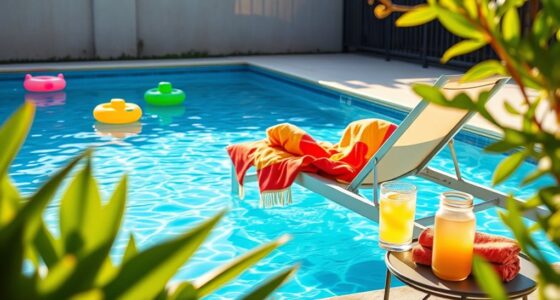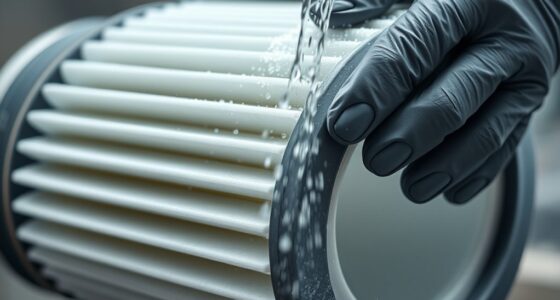Maintaining proper calcium hardness levels prevents scale buildup and surface etching in your pool. Too little calcium causes water to dissolve surfaces, leading to roughness and damage, while too much forms stubborn deposits that clog filters and harm surfaces. Regularly test your calcium levels, and adjust with calcium chloride or by partial water changes as needed. To protect your pool’s surfaces and ensure smooth operation, learn the best strategies to keep calcium balanced properly.
Key Takeaways
- Maintain calcium levels within the recommended range (200-400 ppm) to prevent scale formation and surface etching.
- Regularly test and adjust calcium hardness to avoid imbalances that cause calcium carbonate buildup.
- Use calcium chloride to raise calcium levels gradually, avoiding rapid changes that can promote scaling.
- Drain and refill with low-calcium water if levels are excessively high to reduce scale risk.
- Incorporate stain and scale preventers to inhibit calcium deposits and protect pool surfaces.
Understanding the Role of Calcium Hardness in Pool Water Balance
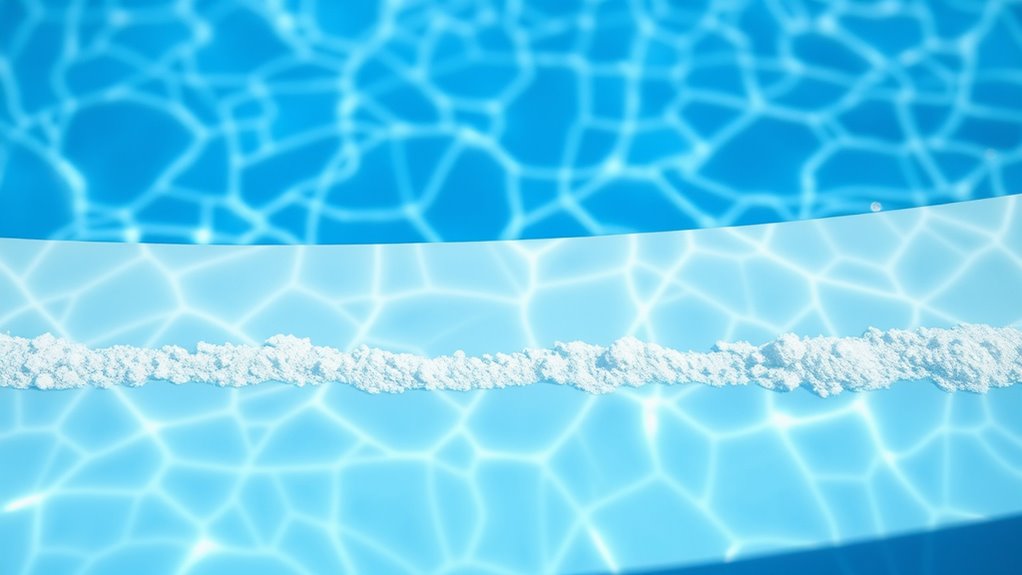
Calcium hardness plays an essential role in maintaining a balanced and healthy pool water environment. It measures the amount of dissolved calcium ions (Ca2+) in your water, usually in parts per million (ppm). Proper calcium levels prevent water from becoming corrosive or forming scale, helping to keep your pool’s chemistry stable. The ideal range is generally between 200 and 400 ppm, but it can vary based on your pool surface, water source, and climate. Calcium hardness is a key component of the Langelier Saturation Index, which predicts scaling or corrosive tendencies. When maintained correctly, it protects your pool surfaces, equipment, and plumbing while ensuring safe, clear water. Regular testing and adjustments keep calcium levels in check, promoting overall water stability. Monitoring calcium levels is crucial for preventing problems such as etching or scaling that can damage your pool.
How Low Calcium Hardness Causes Pool Surface Damage
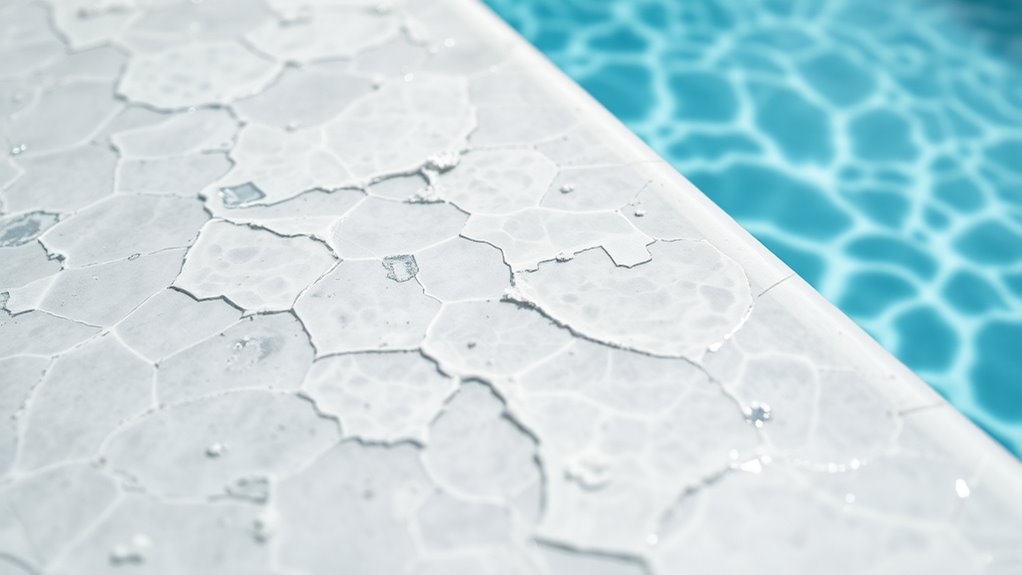
When calcium levels in your pool water drop too low, the water becomes aggressive and starts to dissolve calcium from the pool’s surfaces. This process, known as etching, causes plaster, concrete, and grout to become rough, pitted, or discolored. As the water seeks calcium to balance itself, it erodes the surface material, leading to deterioration that’s often irreversible without repairs. Concrete and plaster surfaces suffer from pitting and erosion, and grout between tiles dissolves, risking loose or missing tiles. Metal components like ladders and heaters also face corrosion, shortening their lifespan. Over time, continuous low calcium hardness results in expensive repairs, decreased water clarity, and compromised pool comfort. Maintaining proper calcium levels helps prevent this damaging cycle. Regular testing and adjustment are essential to keep calcium levels within the recommended range and protect your pool’s surfaces.
The Impact of Excess Calcium on Pool Equipment and Surfaces

Excess calcium in your pool water leads to the formation of stubborn calcium carbonate scale on surfaces and equipment, creating a white, chalky crust that’s difficult to remove. This scale buildup damages pool plaster, tile grout, and decorative finishes by making surfaces rough and abrasive. It often accumulates on tile lines, spillways, water features, and salt chlorinators, leading to unsightly appearances and costly cleaning. Calcium silicate scale, a harder variant, resists removal even more. Additionally, excess calcium causes persistent cloudy water, trapping dirt and microorganisms, which worsens water quality and irritates swimmers’ skin and eyes. Scale deposits inside filters and pipes restrict water flow, stressing pumps and reducing efficiency. Heaters suffer from heat transfer issues, raising energy costs, and may eventually fail if scale isn’t managed. Proper water balance is essential to prevent scale formation and maintain clear, healthy water in your pool.
Monitoring Calcium Hardness: When and How to Test
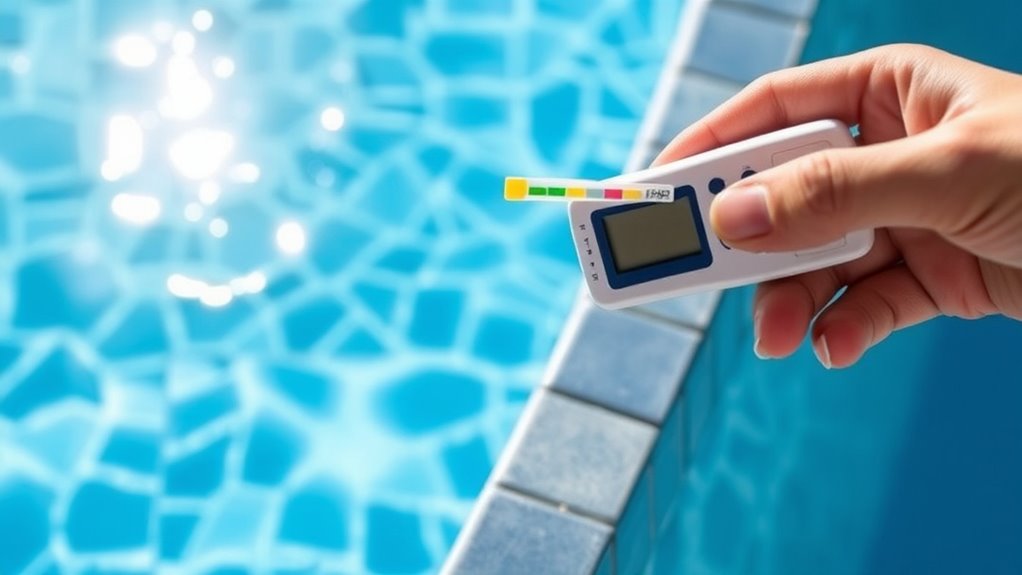
Regularly monitoring your pool’s calcium hardness guarantees water balance and helps prevent scale buildup or corrosion. Test monthly to catch changes early, especially after large refills or significant water exchange. Proper testing ensures accurate readings, which is essential for maintaining the right calcium levels. Ensuring proper water testing procedures can prevent costly damage to your pool surfaces. Quarterly testing can suffice if your water remains stable and low in calcium. After heavy rain or dilution events, test again to ensure levels stay within the ideal range. Use a drop-based titration kit like Taylor K-2006 or K-2005 for accurate results. Rinse the comparator tube, add reagents, and count drops until the color shifts from pink to blue. Multiply the drops by 10 or 25, based on your sample size, to determine ppm. Keep detailed records to track trends and adjust calcium levels proactively, maintaining excellent water quality and protecting your pool surfaces.
Strategies for Adjusting Calcium Hardness Levels Safely
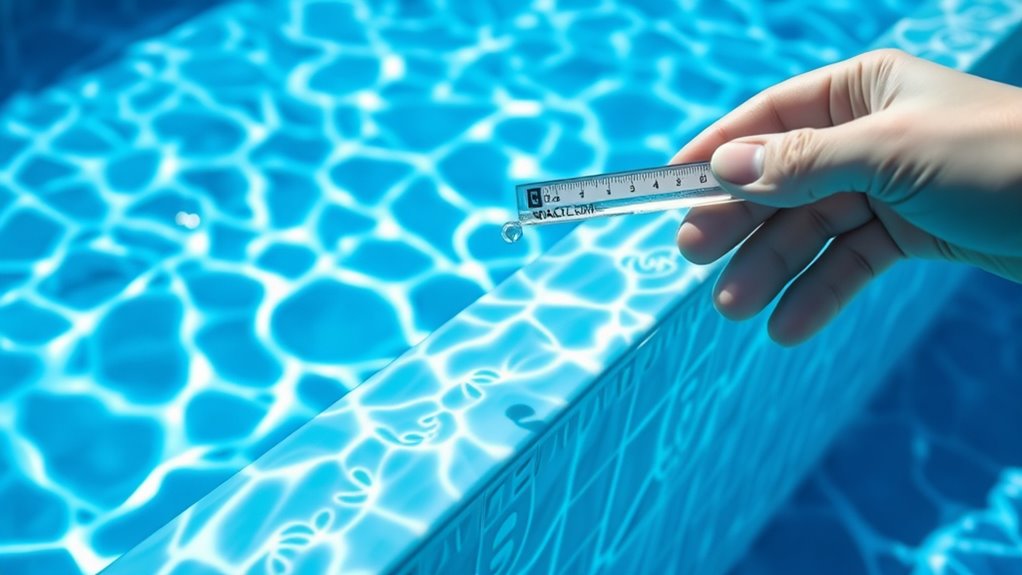
To adjust calcium hardness levels safely, you need to choose the right method based on whether you want to raise or lower the calcium content. To raise calcium hardness, use calcium chloride, broadcasting it evenly over the pool surface with the pump running. For every 10,000 gallons, 1 to 1.25 pounds of calcium chloride increases calcium levels by 10 ppm. Always follow label instructions and wear protective gear. To lower calcium hardness, partially drain the pool and refill with fresh water, which naturally dilutes calcium levels. You can also use calcium binding agents temporarily, but they require repeated applications. Avoid rapid or excessive adjustments, as they can destabilize chemistry or damage pool surfaces. Always test water regularly to ensure levels stay within recommended ranges for your pool type. Regular testing ensures accurate adjustments and helps prevent potential issues related to calcium imbalance.
Protecting Different Pool Surfaces From Calcium-Related Damage
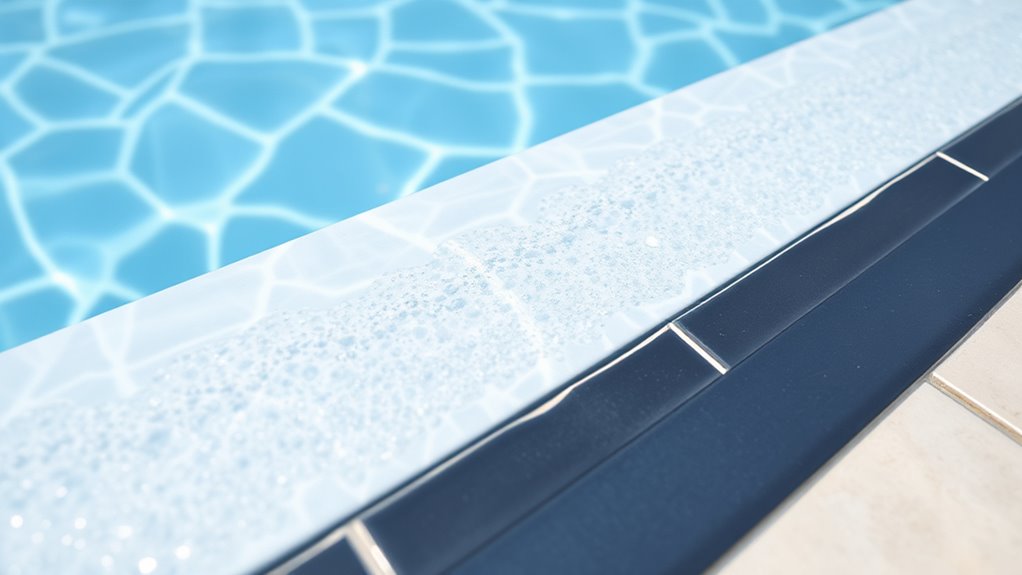
Different pool surfaces respond uniquely to calcium levels, so maintaining proper chemistry is crucial to safeguarding your pool. High or low calcium hardness can cause damage like scaling, etching, or surface deterioration, depending on the material. Regular maintenance and tailored strategies help ensure your pool stays in great shape and lasts longer. Arizona’s water naturally high in calcium and minerals makes it especially important to monitor and adjust water chemistry to prevent damage. Proper water chemistry management can help prevent these issues and extend the lifespan of your pool surfaces.
Surface Compatibility and Calcium Levels
Understanding the specific calcium hardness requirements for your pool surface is crucial to prevent damage and guarantee longevity. Vinyl and fiberglass pools need calcium levels between 175 and 225 ppm to avoid surface damage and chalking. In contrast, concrete and plaster pools require higher levels, typically 200 to 500 ppm, to prevent surface corrosion and pitting. Fiberglass pools are sensitive to high calcium combined with high pH, which can cause chalking, discoloration, and scale buildup. Vinyl liners are more tolerant but still need monitoring to prevent damage from extreme calcium levels. Maintaining the correct calcium range helps minimize scale formation and protects both the surface and equipment. Regular testing and balanced water chemistry are essential for ensuring your pool surface remains protected and in good condition. Additionally, understanding calcium hardness and its impact on different surfaces helps in making informed adjustments to water chemistry.
Damage Risks for Pool Types
Maintaining proper calcium hardness levels is key to preventing damage to your pool’s surface and equipment. For concrete and plaster pools, low calcium causes water to leach calcium from the surface, leading to etching, pitting, and deterioration. High calcium promotes scale buildup, which roughens surfaces, clouds water, and hampers circulation and filtration. In fiberglass pools, excessive calcium hardness can cause surface scaling, discoloration, and chalking, while low levels risk corrosion of metal fittings. Vinyl liners are sensitive to low calcium, which can increase porosity, wrinkling, and fading, though high calcium rarely causes scaling on vinyl. Additionally, improper calcium balance accelerates corrosion of metal components and promotes scaling on equipment, reducing lifespan and efficiency. Regular testing and balancing are essential to protect each pool type from calcium-related damage. Maintaining proper calcium levels is crucial for ensuring the longevity and optimal performance of all pool surfaces and equipment. Proper calcium management also helps prevent scale formation, which can be difficult to remove once established.
Maintenance Strategies for Longevity
To guarantee your pool remains in top condition and resists calcium-related damage, regular maintenance and targeted strategies are essential. Test calcium hardness weekly to catch imbalances early and prevent damage. Balance pH and alkalinity first, as they influence calcium behavior. Use accurate liquid test kits for reliable readings. After heavy use or weather changes, increase testing frequency. To adjust calcium levels, add calcium chloride to raise low levels or drain and refill with low-calcium water to lower high levels. Clean surfaces regularly to prevent calcium buildup, and inspect filters and salt cells to avoid calcium accumulation. Maintain calcium hardness within recommended ranges for your pool type—175–225 ppm for vinyl and fiberglass, 200–400 ppm for plaster and concrete—to ensure surfaces stay protected and durable. Regular testing helps detect small changes before they become serious issues, which is crucial for maintaining proper calcium levels and preventing scale buildup or etching.
Best Practices for Maintaining Optimal Calcium Hardness
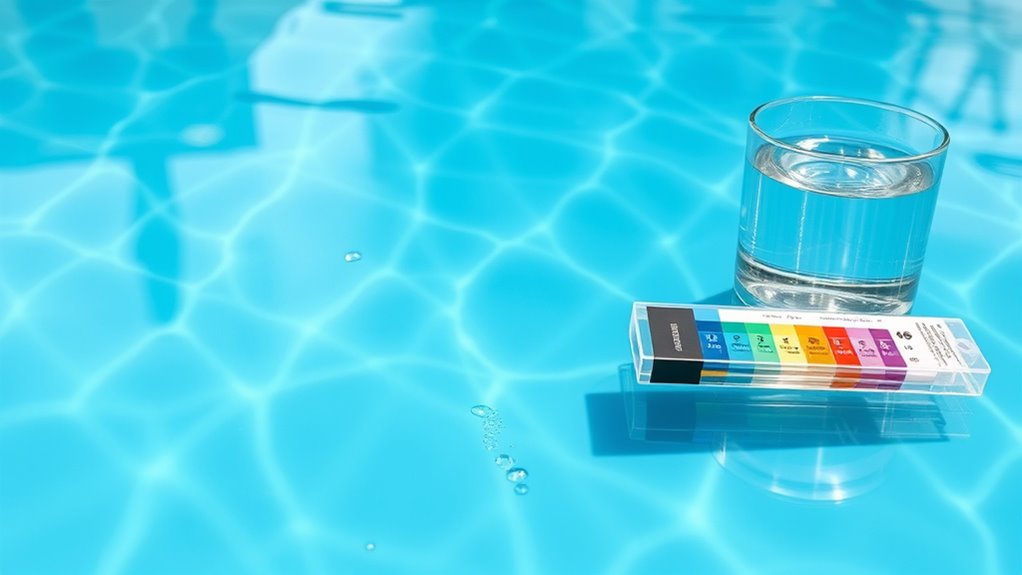
Keeping calcium hardness levels in the ideal range is essential for ensuring your pool stays clear, balanced, and free from damage. To do this effectively, you should:
Maintaining proper calcium hardness prevents damage and keeps your pool clear and balanced.
- Regularly test calcium levels with a reliable liquid test kit after adjusting pH and alkalinity, as these influence readings.
- Raise low calcium hardness by adding calcium chloride, broadcasting it over the pool with the pump running, and avoiding pre-dissolving to prevent cloudiness.
- Lower high calcium by partially draining and refilling with low-hardness water or using acid to reduce pH and alkalinity, which helps control calcium saturation.
- Regular maintenance and monitoring are critical, as filter replacement and proper cleaning help ensure the effectiveness of your water balance efforts.
Consistent monitoring and adjustments help maintain suitable calcium levels, preventing scale buildup and etching. Incorporate stain and scale preventers as needed to protect your pool surfaces and equipment.
Frequently Asked Questions
How Does Calcium Hardness Affect Overall Water Ph Stability?
You might think calcium hardness directly affects pH, but it actually influences water’s ability to resist pH changes. When calcium hardness is balanced, it helps maintain stable pH levels by acting as a buffer. If calcium hardness is too low, water can become corrosive, causing pH to drop and become unstable. Conversely, high calcium hardness can lead to pH rising, making water more prone to scale formation and imbalance.
Can Natural Water Sources Influence Calcium Hardness Levels?
Natural water sources definitely influence calcium hardness levels, and knowing this helps you manage your water quality effectively. You might think that all rainwater is soft, but groundwater from limestone areas can be very hard. Regions with limestone or dolomite rocks dissolve minerals into water, increasing calcium levels. Understanding your source—whether it’s rain, surface, or groundwater—lets you predict calcium hardness and take proper treatment steps to prevent issues like scale buildup or corrosion.
What Are Signs of Calcium Scale Buildup Visible in Pools?
You’ll notice calcium scale buildup as white or grayish-white chalky deposits along the waterline, on tiles, and pool walls. It can cause a dull, cloudy appearance and may lead to roughness or scratches on surfaces. Rust stains, especially on metal fittings, indicate calcium deposits. Additionally, you might see stubborn white-gray stains, dust, or film, and equipment issues like pinhole leaks or reduced salt cell efficiency.
Are There Environmentally Friendly Methods to Manage Calcium Hardness?
You can manage calcium hardness environmentally by using natural methods like plant biomass adsorption, which captures calcium ions sustainably. Organic additives such as saponin, caffeine, and tannic acid act as biodegradable scale inhibitors, disrupting crystal growth. Physical methods like partial water drainage and filtration help dilute calcium levels without chemicals. Combining these approaches with sustainable precipitation techniques offers an eco-friendly way to control hardness while minimizing environmental impact.
How Often Should Calcium Hardness Be Tested in Different Climates?
You should test calcium hardness regularly to keep your pool happy. In warm climates, check at least once a month, but bump it up to twice a month during peak summer or after heavy use. In colder weather, once a month suffices, though testing more often after storms helps catch changes early. Changeover climates call for monthly checks, especially during seasonal shifts, to maintain a balanced, inviting pool all year round.
Conclusion
Maintaining the right calcium hardness level is essential—you’ll prevent costly damage and keep your pool surfaces and equipment in top shape. Did you know that over 80% of pool issues stem from improper calcium levels? Regular testing and adjustments make all the difference, so stay proactive. By understanding and managing calcium hardness, you’ll enjoy a cleaner, clearer, and longer-lasting pool all season long.




